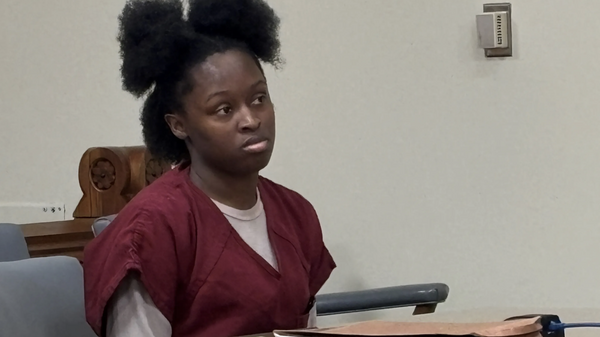Dozens of outstretched arms grasped past a barricade set up on Wednesday afternoon outside Tijuana’s Benito Juárez sports complex as volunteers handed out used shoes, donated jeans and an assortment of tops.
Inside, more than 4,700 Central Americans have been living crammed together on the ground beneath trees and awnings, pressed up against fences, on the baseball field, in the gymnasium, on the basketball court, by the jungle gym.
With each passing day, the population inside the makeshift shelter has mounted, and conditions have been growing more desperate. The future for its occupants has remained uncertain. And Tijuana is facing a crisis unseen in its 129-year history.
“This took us all by surprise, while in the comfort of our armchairs, and nobody likes to be forced to move from an armchair,” said César Martínez, a 47-year-old entrepreneur and cycling activist who is among hundreds of volunteers who have stepped up since the shelter’s opening on Nov. 14.
Since the Central Americans began arriving this month, reactions have run the gamut, ranging from demands for their expulsion to calls for their support.
Even in his circle of friends, Martínez has found no consensus about the presence of the Central Americans in Tijuana. “Of 10 friends….five are in favor, five are against,” he said.
The debate is likely to continue. State authorities say by the time it is over, as many as 9,000 Central Americans will have arrived in Tijuana with the hope of crossing to the United States.
Many of them are from Honduras, a country beset by violence and poverty, and came with the intention of seeking asylum in the United States.
But under a Trump administration proposal, they may not even have a chance to leave Mexican soil. The policy, if approved, would have asylum seekers wait in Mexico while their claims are reviewed.
“We are going to be talking about Tijuana before this migration and after this migration,” said Mayor Juan Manuel Gastélum.
In Tijuana near the U.S. border fence, a gritty block of broken sidewalks in Tijuana’s Zona Norte, now closed to traffic, has become ground zero for the Central Americans as they ponder their next move. Still, the effects have rippled far beyond the neighborhood near the U.S. border fence and jolted residents of this city of 1.8 million into a new reality.
Enrique Méndez, a high-ranking state government official in Tijuana, has heard complaints from Tijuana doctors that their U.S. patients have been canceling appointments as the U.S. government has stepped up security at the ports of entry, and wait times to return to the San Diego have grown longer.
“I’m getting a lot of comments from people saying, I won’t be able to cross to Tijuana, I have to go live with a family member in San Diego, because I work there,” Méndez said.
Tijuana is a city built by migrants, drawing people from across Mexico, and other parts of the world. Residents have seen waves of Chinese, Iraqi Chaldeans, and most recently Haitians who arrived by the thousands in 2016 to seek asylum in the United States.
“Tijuana is a space of migration,” said Tonatiuh Guillén López, a Tijuana academic who has been tapped to head Mexico’s National Migration Institute when Andrés Manuel López Obrador becomes president on Dec. 1. “These are the values that have created this society, this capacity to include, to absorb, and to move toward the future.”
But the massive and very public arrival of the Central Americans this month has also given voice to fears and uncertainties that were never publicly expressed.
A common fear is that the presence of the Central Americans will lead to increased crime; opponents of their presence point to images showing a group of Central American migrants breaking down a fence as they pushed their way into Mexico from Guatemala last month.
“This is not the way to arrive here,” said Gustavo Chavarín, a state employee and secretary in the local committee of Mexico’s National Action Party, standing one evening last week outside the popular Palacio Royal restaurant owned by descendants of Chinese immigrants.
“They should not have crossed illegally,” he said of the Central Americans, adding that “I’ve become aware that they have been joined by a number of criminals.”
On Tuesday morning, a group of several hundred people packed the Tijuana Cultural Center, listening intently as academics from the Colegio de la Frontera Norte analyzed the caravan.
“Some people in Tijuana have reacted with hostility,” said Oscar Contreras, secretary-general of the government-funded think tank that specializes in border issues. “This is understandable, but not justifiable, it’s based on lack of information.”
Later that day, at the Tijuana Chamber of Commerce, federal immigration officials and Tijuana’s public safety secretary discussed the situation with members of the Citizens Public Safety Council.
In downtown, at the independent arts space Lugar del Nopal, staff from the United Nationals High Commission on Refugees briefed volunteers about Mexico’s asylum process.
“Every day, more people are coming forward, and saying, ‘How can I help?’” said Soraya Vázquez, of the Comite Estratégico de Ayuda Humanitaria, whose members have been working to coordinate private donations.
On Thursday morning, maquiladora executives gathered at a hotel near the Otay Mesa border crossing to learn the steps to hiring Central Americans for thousands of entry-level factory jobs that they are struggling to fill.
Tijuana’s maquiladora industry has between 7,000 and 10,000 vacancies, said Salvador Díz, president of the Association of Industries in Otay Mesa, and a shortage of labor has prompted employers to recruit workers in southern Mexico.
More than any other branch of government, it is the city of Tijuana that has borne the brunt of the caravan’s arrival. It has been putting them up in the Unidad Deportiva Benito Juárez, staffing it with city employees, many of whom have been volunteering extra hours, and assigning police to maintain control.
Mayor Gastélum has found himself the target of much criticism for his depiction of the group in an interview on Mexican national television, saying they “come with an aggressive, rude stance,” asserting that some are “lazy, marijuana smokers.”
By Thursday, he had declared a humanitarian crisis, calling on international aid organizations to step forward, and accusing the federal government of leaving the city alone to cope with the situation.
The city’s public safety secretariat reported that as of Thursday, more than 100 Central Americans had been detained, most of them for non-violent crimes involving drug possession, being drunk in public, or disturbing the peace.
“Tijuana is a city where our fathers were received with open arms,” said Monica Vega, a Tijuana council member. “I think what we’re simply seeing is uncertainty and lack of leadership.”
The arrival of the Central Americans has come two years after another large influx — of some 20,000 Haitians who flocked to Tijuana, many of whom made their way to the U.S. border after years of working in Brazil.
Some authorities have been quick to point out that the Haitians caused no problem. Some 3,800 who decided not to seek asylum in the United States have stayed behind in Baja California and assimilated quickly.
There have been key differences. While the Central Americans are undocumented, the Haitians typically came to the U.S. border with temporary transit visas authorized by the Mexican federal government.
Rather than moving like the Central Americans in large public caravans, the Haitians arrived at the border in smaller groups. And while the Central Americans have been determined to stay together — a measure of self protection — the Haitians dispersed. As established shelters became overwhelmed, evangelical groups opened their spaces as provisional shelters for the Haitians.
“There was great synergy around the situation,” as government institutions and migrant protection groups stepped forward, said Laura Velasco, a researcher at the Colegio de la Frontera Norte.
Ustin Pascal Dubuisson, 25, is among those Haitians who have settled in Tijuana. He has written a book about his journey, and joined a group, Espacio Migrante, that advocates for migrants.
The accounts that Haitians were readily accepted, “are a myth,” he said, “You’d always hear, ‘How come Haitians can own a smartphone? Why can they buy food?”
As he walked into the Benito Juárez stadium one day last week, Dubuisson said, “it’s a really difficult situation, but the one thing that people can do is refrain from judging, to accept people, and to give them the same opportunity that they gave Haitians.”







